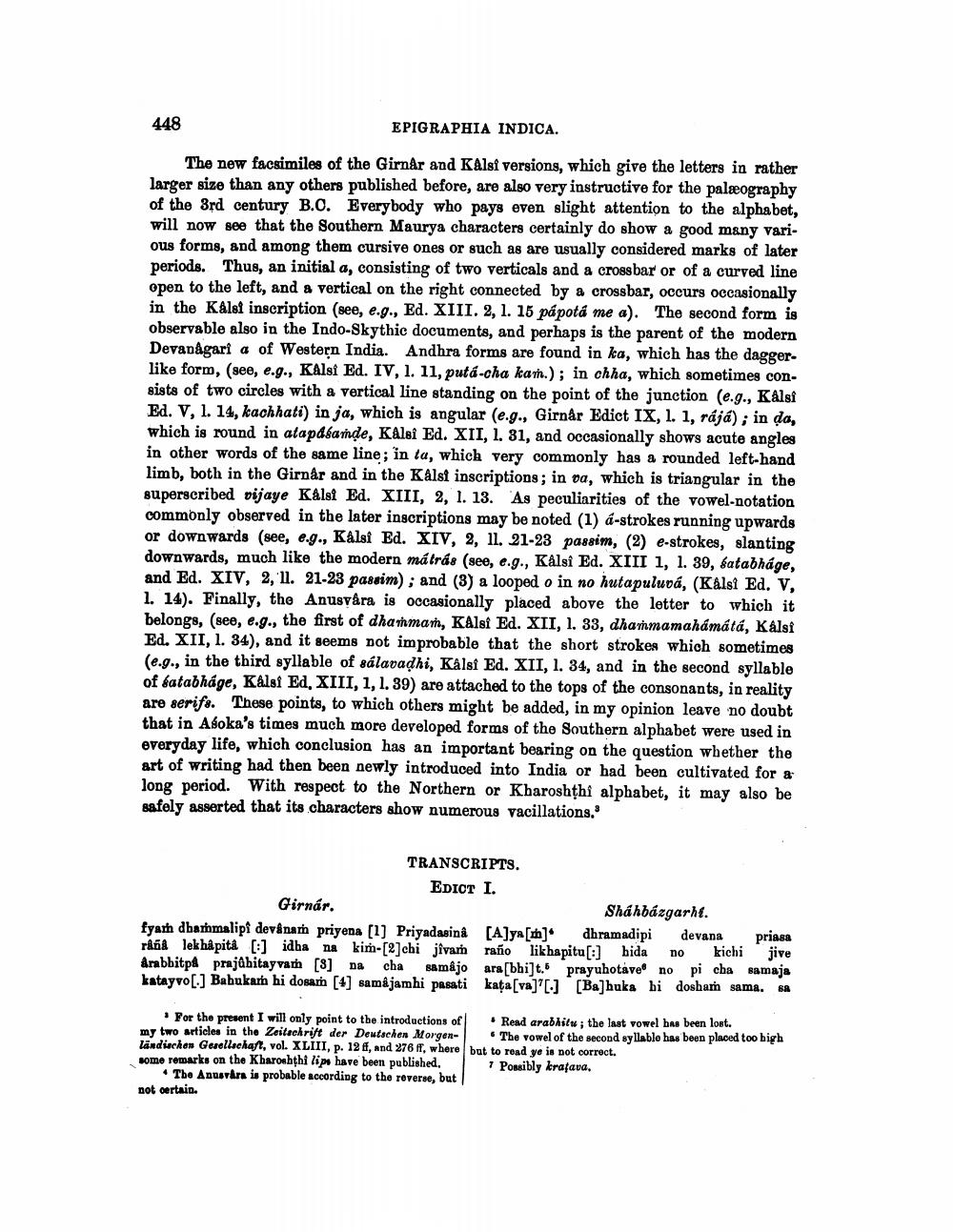________________
448
EPIGRAPHIA INDICA.
The new facsimiles of the Girnar and KAlsi versions, which give the letters in rather larger size than any others published before, are also very instructive for the palæography of the 3rd century B.O. Everybody who pays even slight attention to the alphabet, will now see that the Southern Maurya characters certainly do show a good many various forms, and among them cursive ones or such as are usually considered marks of later periods. Thus, an initial a, consisting of two verticals and a crossbar or of a curved line open to the left, and a vertical on the right connected by a crossbar, occurs occasionally in the Kalsi inscription (see, e.g., Ed. XIII. 2, 1. 15 pápotá me a). The second form is observable also in the Indo-Skythic documents, and perhaps is the parent of the modern Devanagari a of Western India. Andhra forms are found in ka, which has the dagger. like form, (see, e.g., Kalsi Ed. IV, 1. 11, putá-cha kam.); in chha, which sometimes consists of two circles with a vertical line standing on the point of the junction (e.g., Kalsi Ed. V, 1. 14, kachhati) in ja, which is angular (e.g., Girnår Edict IX, 1.1, rájá); in da, which is round in atapasamde, Kalsi Ed. XII, 1. 31, and occasionally shows acute angles in other words of the same line; in ta, which very commonly has a rounded left-hand limb, both in the Girnar and in the Kalst inscriptions; in da, which is triangular in the superscribed vijaye Kalsi Ed. XIII, 2, 1. 13. As peculiarities of the vowel-notation commonly observed in the later inscriptions may be noted (1) á-strokes running upwards or downwards (see, e.g., Kalsi Ed. XIV, 2, 11. 21-23 passim, (2) e-strokes, slanting downwards, much like the modern mátrás (see, e.g., Kalsi Ed. XIII 1, 1. 39, Satabháge, and Ed. XIV, 2, 11. 21-23 passim); and (3) a looped o in no hutapuluvá, (Kälsi Ed. V, 1. 14). Finally, the Anusvåra is occasionally placed above the letter to which it belongs, (see, e.g., the first of dhammam, KAlsi Ed. XII, 1. 33, dharmamahámátá, Kalsi Ed. XII, 1. 34), and it seems not improbable that the short strokes which sometimes (e.g., in the third syllable of sálavadhi, Kalsi Ed. XII, 1. 34, and in the second syllable of katabháge, Kalsi Ed. XIII, 1, 1. 39) are attached to the tops of the consonants, in reality are serifs. These points, to which others might be added, in my opinion leave no doubt that in Asoka's times much more developed forms of the Southern alphabet were used in everyday life, which conclusion has an important bearing on the question whether the art of writing had then been newly introduced into India or had been cultivated for a long period. With respect to the Northern or Kharoshthi alphabet, it may also be safely asserted that its characters show numerous vacillations."
TRANSCRIPTS.
EDICT I. Girnar.
Shahbázgarht. fyath dbammalipi devinar priyena (1) Priyadasina [A]y[m] dhramadipi d evana priasa råña lek håpitâ (!) idha na kim-[2]chi jivaṁ raño likhapitu[:] bida no kichi jive Anbbitpa prajůbitayvam [8] na cha småjo ara [bbi]t. prayuhotave no picha samaja katayo [.] Babukarn hi dosam [4] sama jamhi pasati kata[va] [:] [Ba]huka bi dosham sama. Sa
. For the present I will only point to the introductions of Read arabhilse; the last vowel has been lost. my two articles in the Zeitschrift der Deutschen Morgen- The vowel of the second syllable has been placed too high ländischen Gesellschaft, vol. XLIII, p. 12, and 276ff, where but to read ye is not correct. some remarks on the Kharoshthi lipo have been published.
Possibly krafava. • The Anuskrs is probable according to the reverse, but not certain.




